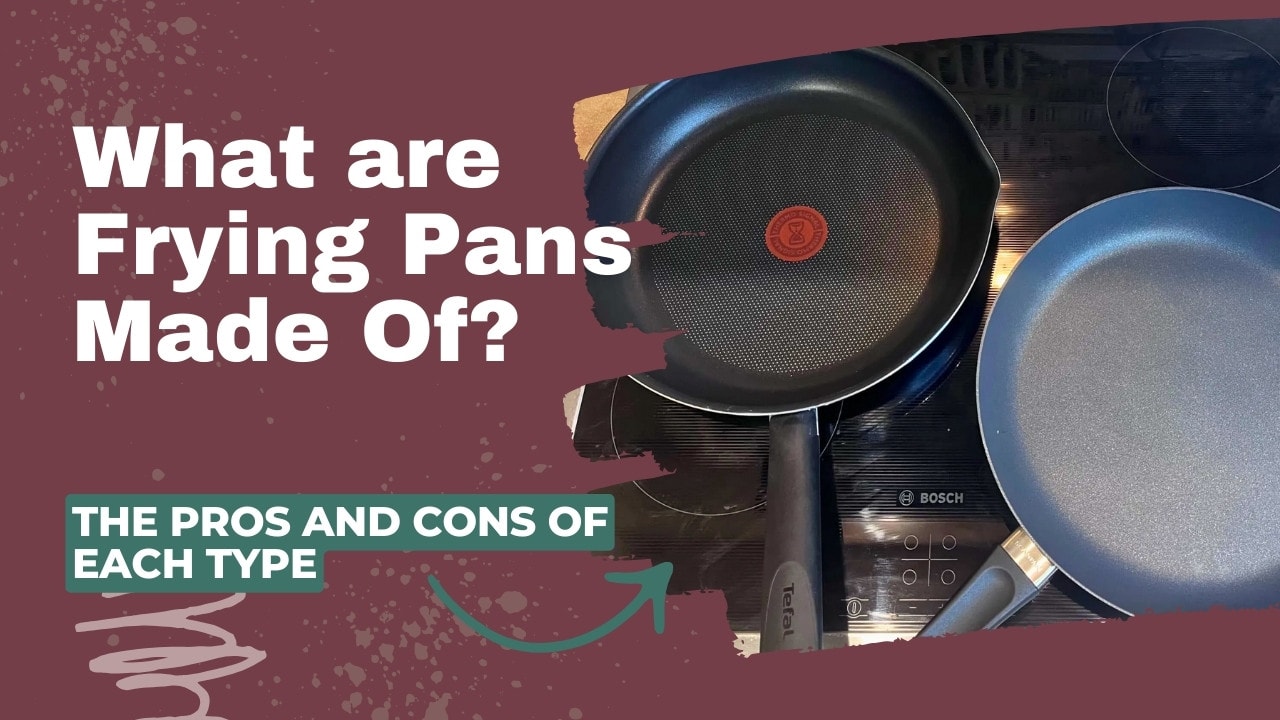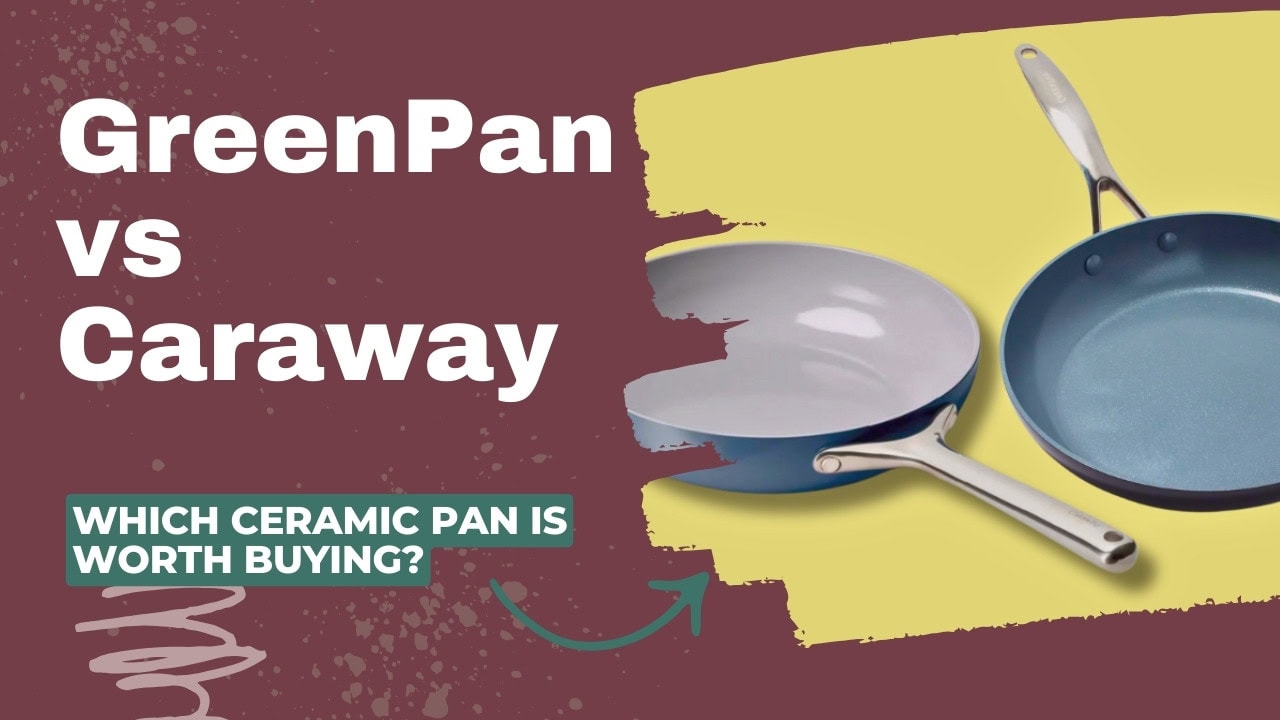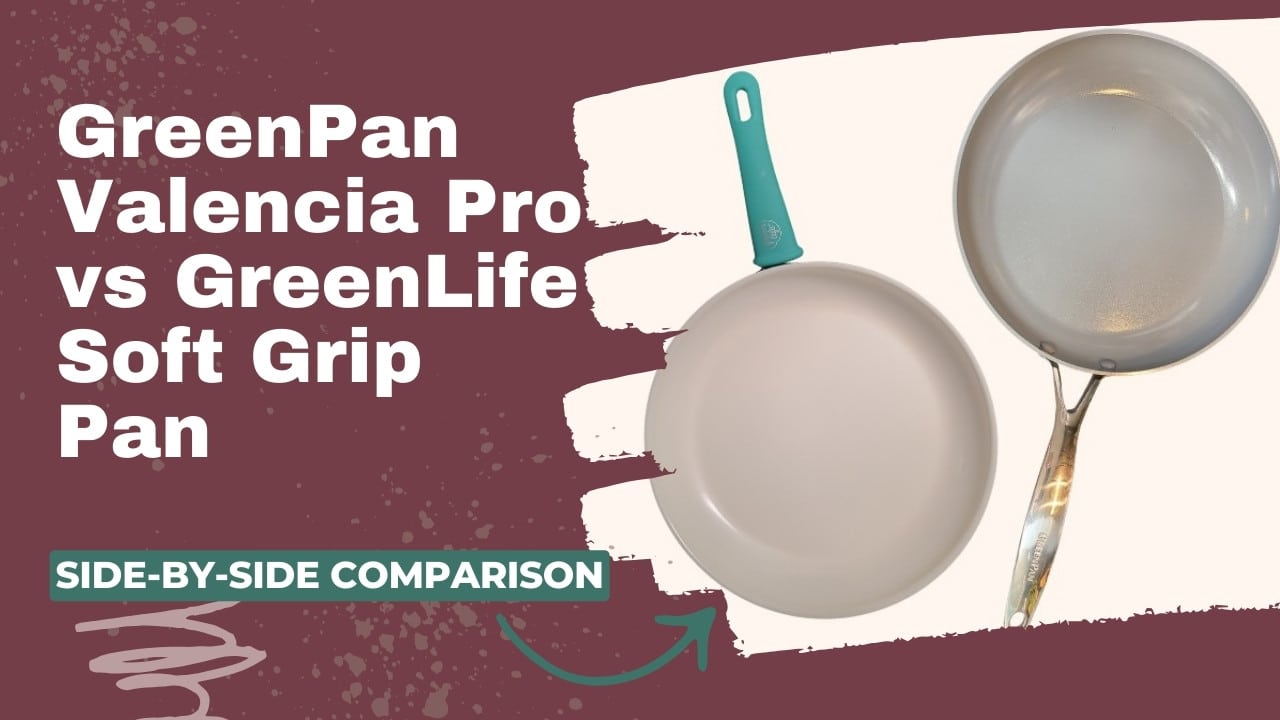Back in my novice cooking days, I once made the disastrous mistake of using a chipped fry pan for my omelet, resulting in a breakfast fiasco that I’d rather forget. That morning mess sparked my quest for the perfect fry pan.
When sorting through all the options, I found fry pans crafted from various materials like aluminum, stainless steel, and even the less common — but notably impressive — carbon steel. Some of them will work wonders in any kitchen, while others have a bit more of a learning curve.
Keep reading to learn more about the different fry pan materials, how they compare, and what types of food you can cook in them.
What Are Frying Pans Made Of?
Frying pans are typically crafted from metals like aluminum and stainless steel, carbon steel, or cast iron. They may be coated in nonstick Teflon (PTFE), nonstick ceramic, or porcelain enamel for a nonreactive, easy-to-use cooking surface.
What Is a Frying Pan?
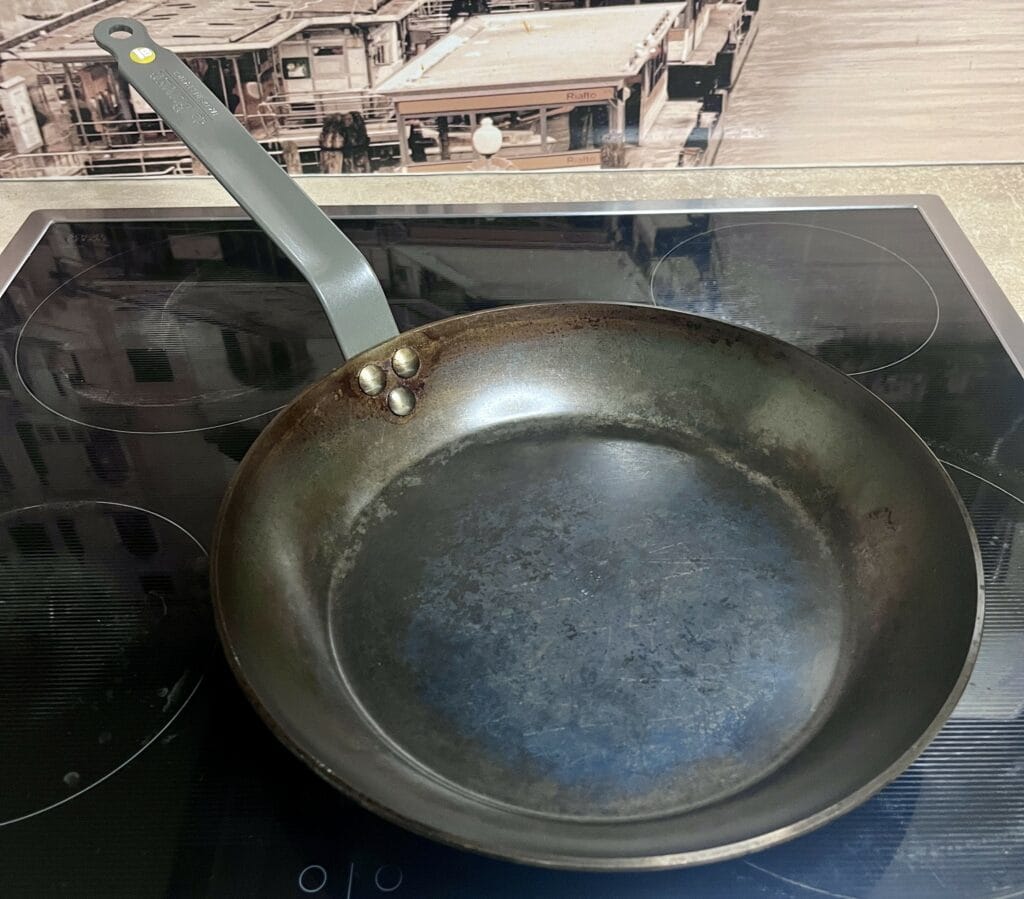
A fry pan, also known as a skillet, is a round, flat-bottomed cooking vessel with shallow sides that can be used for everything from scrambling eggs to crafting the perfect pancake.
This humble cookware typically has slightly flared, sloping sides and a long handle. This design makes it easier to flip, turn, and move ingredients around the pan. Some frying pans also include a smaller helper handle that helps lift it, as a full pan can be quite heavy.
The diameter of a frying pan can range from a petite 6 inches up to a generous 14 inches. I personally like an 8-inch model as it’s wide enough to hold a couple of fish filets yet manageable to flip two pancakes in one go.
The Fine Line Between a Frying Pan and Other Pans
Most people confuse fry pans with sauté pans and saucepans.
A saute pan, similar in shape to a frying pan, has a large cooking surface and features straight sides with a lid. This design makes it a go-to for tasks for sautéing while preventing the food from flying out of the pan.
The saucepan, on the other hand, is a deep cooking pot with higher sides than a frying pan. Its design is suitable for simmering broths, cooking pasta, or making that holiday mulled wine.
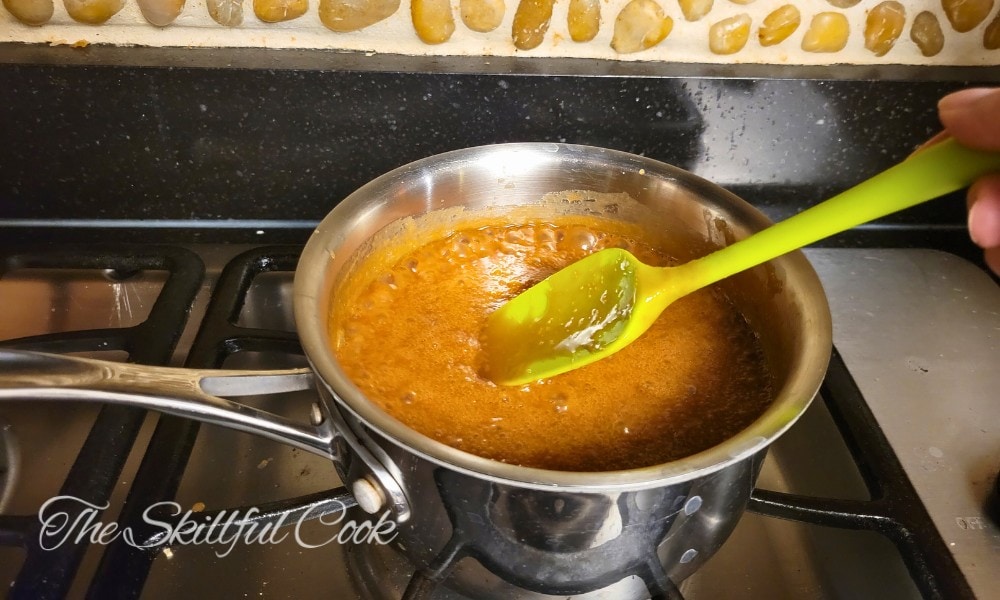
While I have tried making a quick béchamel sauce in my fry pan, I believe the saucepan’s design allows for more stirring room, fewer spills, and better heat distribution.
Types of Frying Pans
You could group fry pan materials into three categories: uncoated metal, seasoned metal, and coated metal.
Comparing Materials for Fry Pans
Following are some of the most commonly used range of different materials available for fry pans, offering various benefits to suit the modern chef’s needs.
Stainless Steel
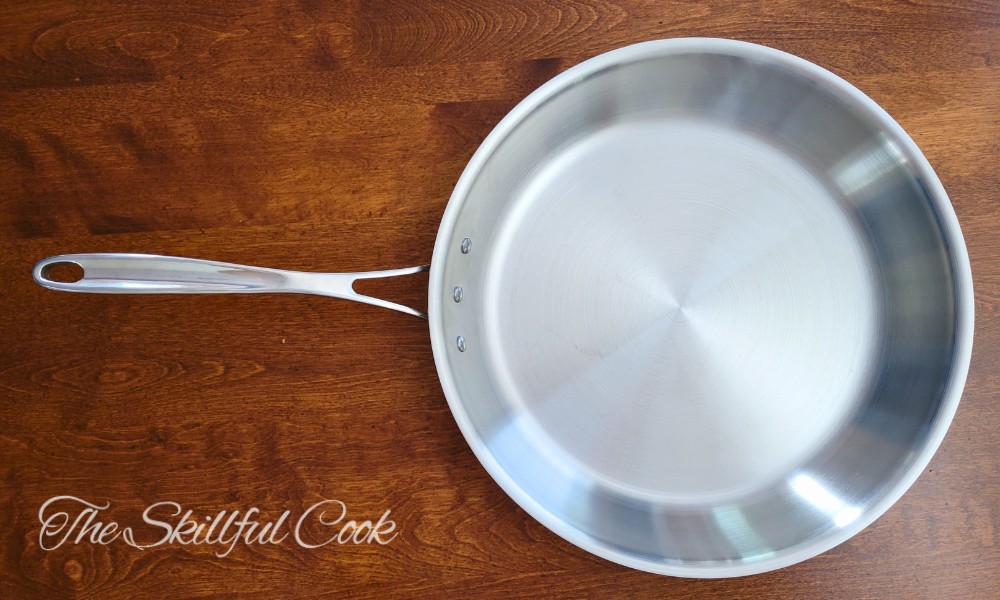
Pros
Cons
Stainless steel cookware is a staple in professional kitchens, prized for its durability and sleek aesthetics. Stainless steel is an alloy composed primarily of iron, nickel, and chromium.
They typically come with layered structures such as 3-ply and 5-ply. A 3-ply fry pan has three layers, typically a stainless-aluminum-stainless structure. A 5-ply, on the other hand, features five alternating layers of stainless and aluminum for even better heat distribution, reducing hot spots.
Perhaps one of the biggest draws of stainless steel fry pans is that they’re non-reactive and corrosion-resistant. While they may release trace levels of nickel and chromium into your food, the FDA confirms these levels to be within safe limits for most people. However, if you have a nickel allergy, you should opt for nickel-free stainless steel, denoted as 18/0.
What Are Stainless Steel Fry Pans Good For?
Stainless steel frying pans are versatile cookware that can handle almost any food, including acidic ingredients like tomato sauce and vinegar. Personally, I swear by my stainless steel pan for those dishes that require a perfect crust.
Another great plus of stainless steel is that it’s oven-safe. This makes them perfect for dishes requiring a combo of stovetop searing and oven finishing, such as steaks.
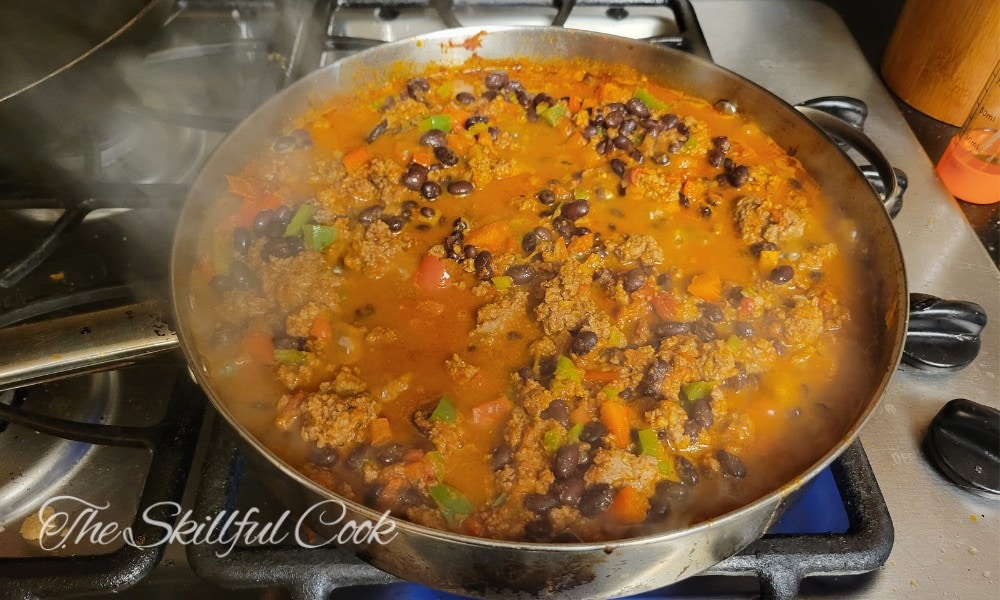
You should avoid using a stainless steel fry pan for cooking delicate proteins. They might stick to the pan or leave behind a gummy residue, especially if the pan isn’t adequately preheated or oiled. If your pan isn’t dishwasher safe or you don’t want to spend hours scrubbing it off, read this guide on how to keep food from sticking to stainless steel pans.
Read our top recommendations. Find the Best Budget Stainless Steel Cookware.
Traditional Nonstick Aluminum
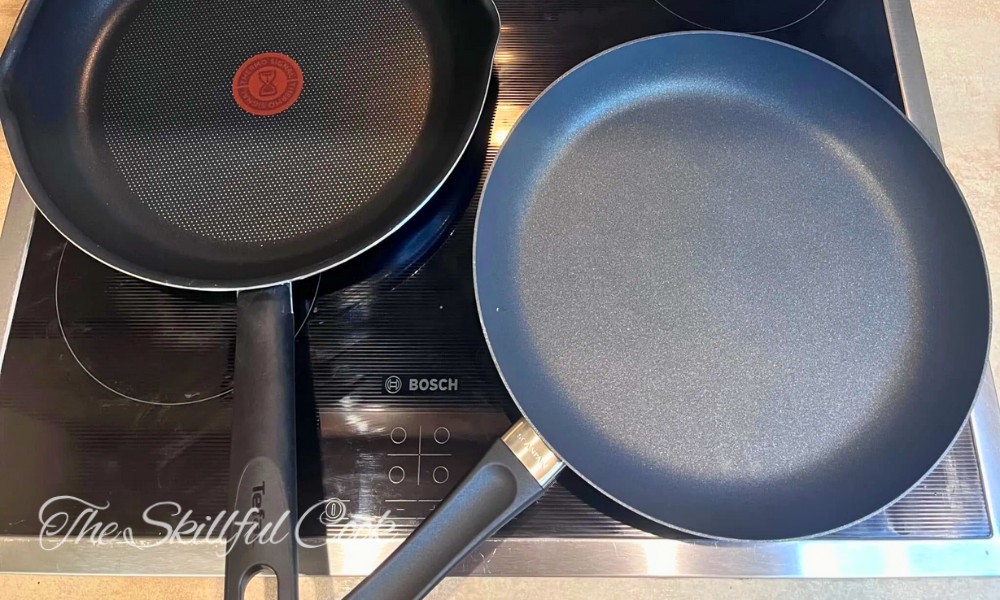
Pros
Cons
Traditional nonstick aluminum fry pans typically feature a lightweight aluminum core with a nonstick coating of Teflon (or PTFE) that’s noncorrosive and non-reactive.
Aluminum is a soft metal, so it’s more prone to warping and denting, especially if subjected to high heat. Make sure you don’t use metal utensils with nonstick-coated pans. They can make scratches in the nonstick coating and reduce its effectiveness.
While most nonstick-coated pans have an aluminum core, some may also have other base materials, like stainless steel or hard-anodized aluminum (more on that below).
What Are Traditional Nonstick Aluminum Pans Good For?
Since modern aluminum fry pans are almost always nonstick, you can use them for cooking foods that are prone to sticking, like potatoes, crepes, and breaded or battered foods. They are also the best option if your priority is cooking with little to no fat or oil.
They can’t handle high heat searing, though. So while your trusty nonstick aluminum frying pan will be perfect for crisping up tater tots, you’ll need to switch to cast iron or carbon steel to get a good sear on a steak.
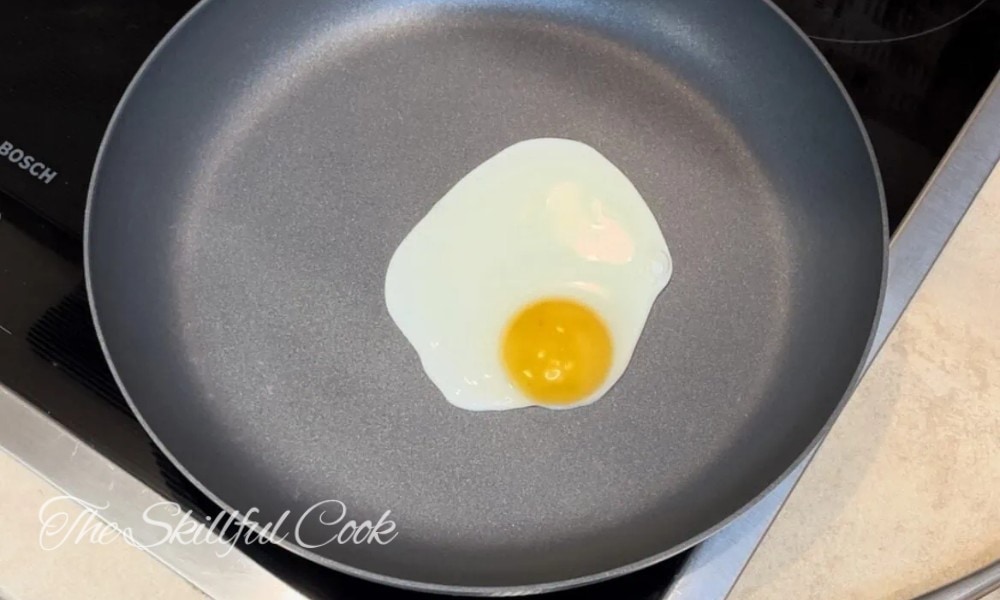
The lower heat tolerance means you have to be more careful when preheating them as well. (An overheated Teflon pan can be toxic to pets!) But for quick weeknight meals, it’s hard to beat the convenience of a good nonstick frying pan.
Ceramic Nonstick
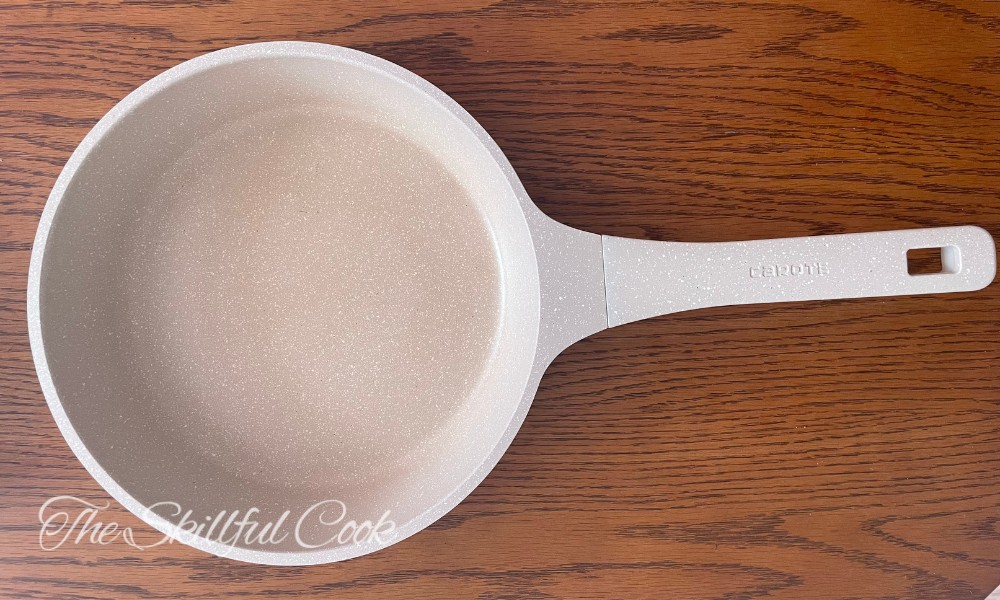
Pros
Cons
If you’re looking for minimalist frying pans that can add a bit of color to your kitchen collection, ceramic nonstick might be worth considering. These pans have a sturdy metal core constructed either of aluminum or stainless steel and are finished with a layer of silica-based coating to mimic the smooth, shiny surface of a traditional ceramic.
Many people consider ceramic cookware a safer alternative to traditional nonstick pans. The ceramic coating is typically free from synthetic polymers (PTFE) and “forever chemicals” or PFAS.
Ceramic fry pans have a brittle coating that may get chipped or scratched easily, potentially leaching metal from the base metal beneath the ceramic coating.
I like to use wooden or heat-resistant silicone utensils when cooking with ceramic pans to help them last longer.
What Are Ceramic Nonstick Fry Pans Good For?
Ceramic fry pans have a low direct heat tolerance – which means you shouldn’t use them above the “medium” setting on your stove. Some are oven-tolerant up to 500 degrees Fahrenheit, but not all. High-temperature cooking can damage the nonstick coating.
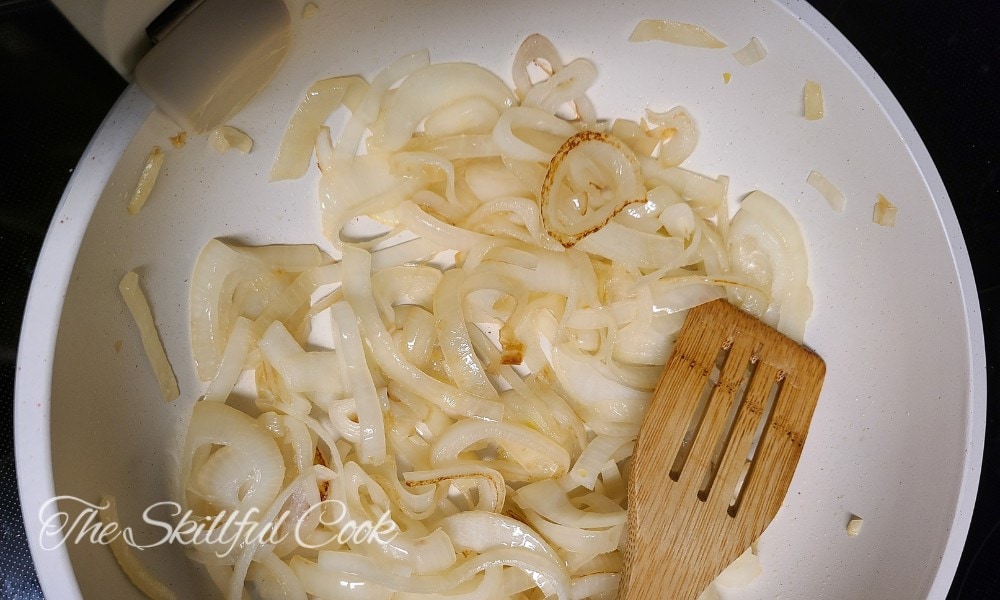
So ceramic frying pans are better suited for low or medium-heat dishes rather than high-temperature searing. Think breaded crab cakes, crepes, scrambled eggs, and anything else that doesn’t require high heat. Most can handle cooking with little to no oil, at least until the ceramic coating begins to wear out.
Hard Anodized Aluminum
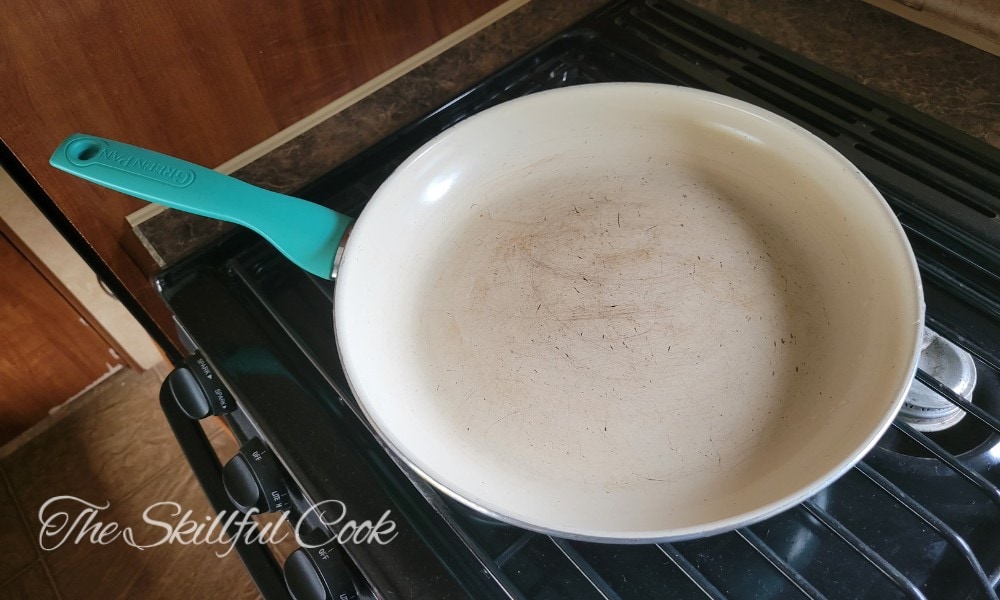
Pros
Cons
Since aluminum is typically soft and tends to corrode, manufacturers may treat the aluminum with an electrochemical process called anodizing. This technique creates a protective oxidized layer on the surface of the aluminum that makes it twice as hard as stainless steel and resistant to corrosion and scratching.
Hard anodized aluminum can withstand high temperatures. In fact, this frying pan can handle up to 3632 degrees Fahrenheit – but the limiting factor is typically the nonstick coating.
If you’re using a hard anodized aluminum fry pan with a Teflon coating, it can release toxic fumes if heated over 500 degrees Fahrenheit.
What Are Hard Anodized Aluminum Fry Pans Good For?
You may be able to find vintage hard anodized aluminum pans without a nonstick coating, but modern ones are virtually always coated in ceramic or Teflon. This means their best uses are the same as other nonstick pans.
Though aluminum has impressive heat conductivity, the thick oxidized layer on hard anodized aluminum can affect its heat transfer capability. This can lead to hotspots.
Read our Chef’s recommendations. Find the Best Hard Anodized Cookware.
Carbon Steel
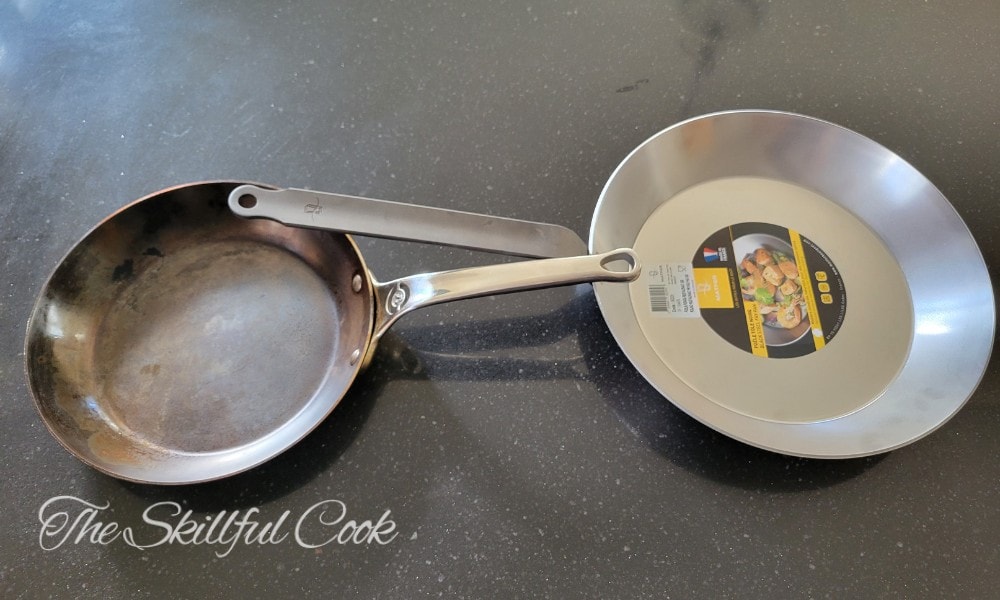
Pros
Cons
If there’s one fry pan material that has never let me down, it’s carbon steel. Carbon steel is made from iron with a little bit of carbon mixed in. This blend creates a steel incredibly durable yet thinner than its cast-iron cousin — making it the perfect alternative to cast iron.
I remember the first time I held one in my hand — it had a heft to it but not that wrist-straining weight typically associated with cast iron pans. That said, carbon steel isn’t exactly lightweight. An average 10-inch carbon-steel pan weighs around 3.5 pounds.
While carbon steel has a smooth surface, it’s not naturally nonstick. If you want to create a nonstick coating and prevent rust, you will have to season it properly.
What Are Carbon Steel Fry Pans Good For
Carbon steel fry pans are great for high-heat cooking. They’re also (usually) oven-safe to fairly high temperatures, making it perfect for baking flatbreads like naan or a thin, crispy pizza. (Some carbon steel pans have a coating on the handle that’s not oven-safe, so be sure to check that!) I love using my carbon steel pan for searing the perfect steak.
Courtesy of their quick heat response, cooking with carbon steel cookware means you can maneuver through different temperature levels seamlessly, which is essential in a good stir fry.
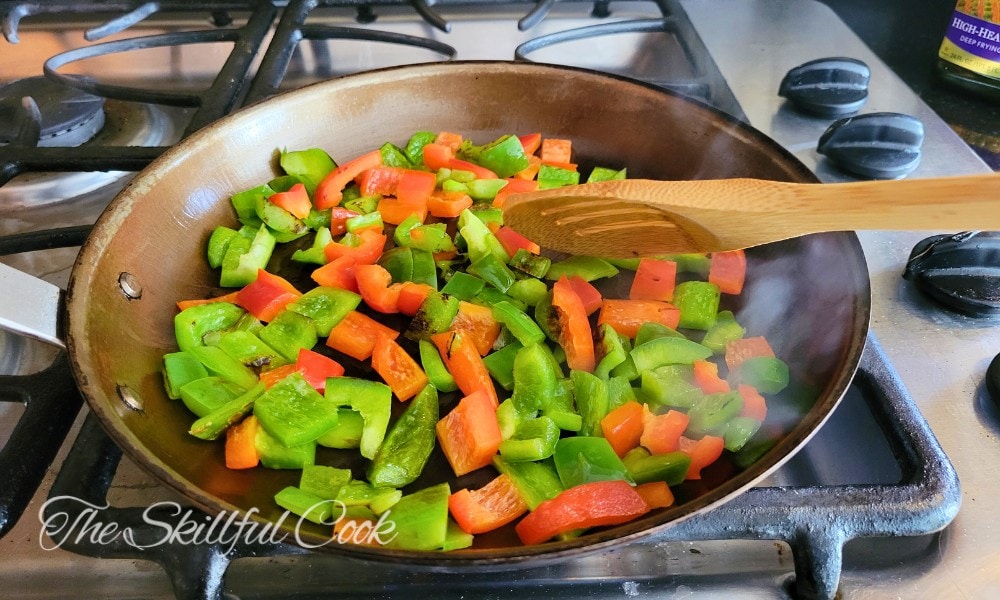
Similar to cast iron, carbon steel retains heat well, so your food will stay warm even after you take it off the burner. The only things you should avoid cooking are highly acidic or sugary foods. This is because the acid can break down the pan’s seasoning, while sugar can stick and caramelize.
Looking for the Best of the Best Carbon steel pan? Check out this Detailed Comparison: Matfer Bourgeat Vs De Buyer Mineral B Carbon Steel Skillets
Cast Iron
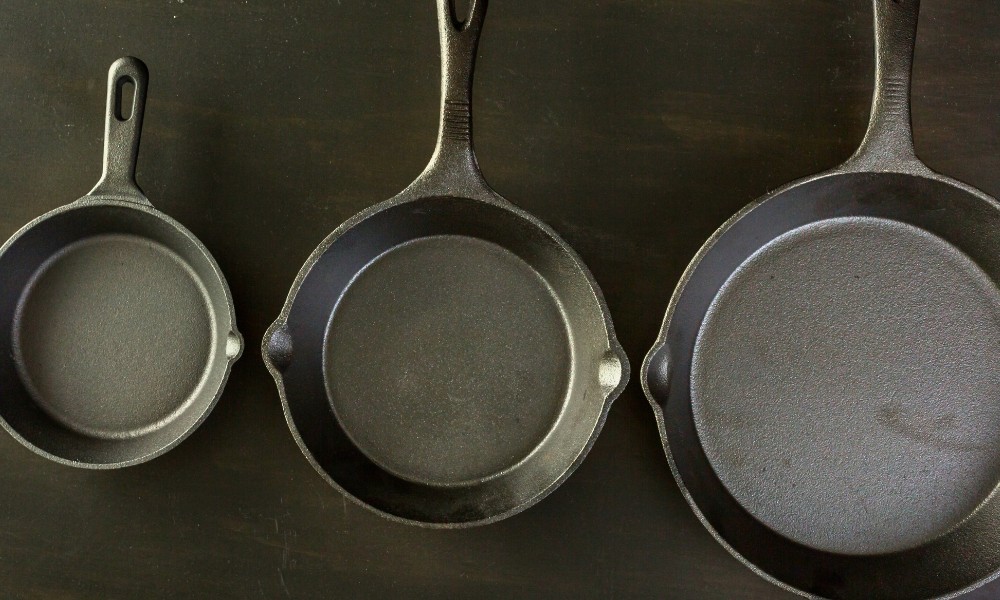
Pros
Cons
I think one can’t discuss all the materials of frying pans without mentioning cast iron. Cast iron frying pans are made of 96-98% iron and 2-4% carbon, depending on the manufacturer. This type of a frying pan is highly durable, has excellent heat-retaining properties, and develops a natural nonstick layer over time.
The downside is that cast iron skillets are heavy and require more care — you have to periodically re-season them and avoid soaking or putting them in the dishwasher. But with proper maintenance, a cast iron pan will likely outlive your other cookware.
Cooking with cast iron also has some potential health benefits to it.
Research shows that cast iron cookware can increase the iron content of your food, which can be beneficial for those looking to up their iron levels.
That said, this can also put some people at risk of an iron overload. If you’re worried about an iron overload, enameled cast iron might be a better option. Enameled cast iron is simply cast iron that’s covered with a porcelain enamel coating. This creates a glass-like coating that won’t rust or transfer iron to your dishes.
While you don’t have to season enameled cast iron, it’s not 100% nonstick — you will still need to use some cooking oil when making food on it. Enameled cast iron fry pans can also crack under extreme temperature variations. So make sure you avoid transferring a hot pan directly to a cold surface.
What Are Cast Iron Fry Pans Good For?
If there’s one thing I like about cast iron, it’s how it excels at tasks like searing pork schnitzel and cooking crispy strip bacon — jobs requiring high heat and consistent temperature.
Avoid cooking acidic food or wine-based sauces on your cast iron pan, as these foods can break down the seasoning. If you’re cooking acidic dishes, you should pull out your enameled cast iron frying pan instead.
If you’re new to cast iron and looking to buy one, I recommend getting a pre-seasoned cast iron skillet. You can use it in the oven, on the stove or the grill, and it costs less than $20.
Other Materials for Fry Pans
Other materials used for fry pans include copper, pure ceramic, uncoated aluminum, and titanium. These each have their own strengths and weaknesses.
A copper fry pan is a classic choice. Thanks to its unmatched heat conductivity, these pans are great for cooking delicate proteins or confections on low heat.
100% ceramic cookware is a less common option. Unlike ceramic-coated cookware which uses a technology invented in the 2000s, 100% ceramic cookware is made from age-old practices and traditional clay. One of the few and best brands is
With its moderate heat tolerance, you can use the Xtrema 100% ceramic pan for sauteing vegetables or searing up a good steak.
Uncoated aluminum stands out for its simple yet effective makeup. These frying pans are made of stamped or cast aluminum and do not have any additional coatings. Today, they are most commonly used as camping cookware, along with titanium camping cookware.
Uncoated aluminum frying pans have high thermal conductivity. However, cooking with uncoated aluminum can leach may increase the risk of neurotoxicity, per MedicalNewsToday.
See our full write-up on “Is aluminum cookware safe?”
Frequently Asked Questions
What’s the most common material for fry pans?
Aluminum is the most common fry pan material, usually coated with ceramic or Teflon nonstick coating. Stainless steel is also popular thanks to its durability and versatility. Many restaurant chefs prefer carbon steel because it holds heat so well, is nonstick when seasoned, and imparts a great flavor to food.
Do all fry pans have Teflon?
No, all fry pans don’t have Teflon. While many manufacturers use Teflon (the brand name for polytetrafluoroethylene or PTFE) for its nonstick property, there are also pans made with alternative nonstick coatings made from “sol-gel” ceramic infused with diamond or titanium. You can also get uncoated fry pans made of copper, stainless steel, or carbon steel.
If you want to avoid Teflon, you can get a good natural nonstick finish on skillets crafted with carbon steel or cast iron with proper seasoning.
What fry pans are non-toxic?
Non-toxic fry pan materials include cast iron, stainless steel, and carbon steel—essentially any fry pan that doesn’t have a coating. These don’t contain potentially harmful elements like PTFE, PFAS, PFOA, lead, cadmium, or aluminum on the cooking surface. Stainless steel includes small amounts of nickel. Please see our full write-up on non-toxic cookware for the pros and cons of each type of frying pan.
The Takeaway
These days, you’ll find fry pans crafted from a variety of materials, each bringing its unique qualities to the kitchen. Some of these frying pans offer incredible heat retention and durability; others boast high-tech, non-stick surfaces for effortless release when making eggs and other sticky foods.
While most home chefs prefer cast iron for its seasoned cooking surface and robustness, others opt for carbon steel for a lighter yet similar performance.
I would love to hear your thoughts! Drop your favorite type of frying pan and your reason for loving it in the comments below.

